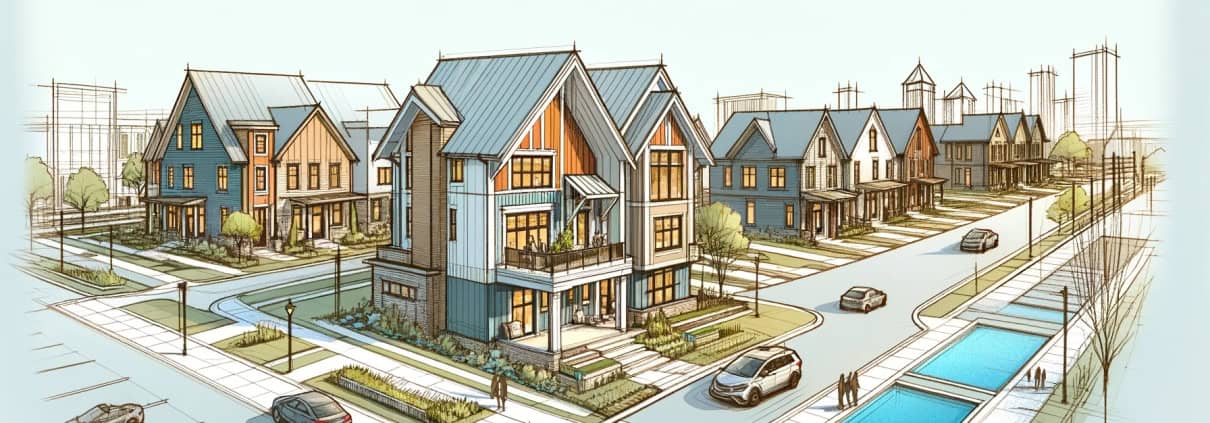Build-to-Rent
Build-to-rent, or BTR, generally refers to the development of single-family homes or duplexes within a neighborhood, all owned by a single entity, and designed specifically for rental purposes. This model diverges from traditional single-family housing developments intended for sale to individual homeowners.
In BTR communities, developers and investors create entire neighborhoods with the intention of managing them as rental properties. This approach allows for uniformity in management, maintenance, and tenant experience, often providing amenities and services akin to those found in multifamily apartment communities, such as community centers, recreational facilities, and landscaping services.
The BTR model caters to a growing segment of the population seeking the lifestyle and space offered by single-family living without the financial or maintenance commitments of homeownership. For investors and developers, BTR projects present an opportunity to capitalize on the demand for residential rental properties, offering the potential for stable rental income streams and long-term capital appreciation, with the added benefit of scalability in portfolio expansion.
Note that the term build-for-rent (BFR) is sometimes used interchangeably with build-to-rent, although BFR may also refer to the general strategy of simply building a project with the intention of leasing it to one or more tenants.
Putting ‘Build-to-Rent’ in Context
In the burgeoning suburbs of Atlanta, Georgia, Greenfield Residential Properties plans to embark on an ambitious (and hypothetical) project: the development of Lakeside Living Estates, a neighborhood comprising 235 single-family homes designed exclusively for rent. This development reflects the growing trend of Build-to-Rent (BTR) where entire communities are built with the intention of offering single-family homes for rental rather than sale.
Greenfield Residential Properties, known for its expertise in both build-to-sell and build-to-rent residential developments, designed Lakeside Living Estates to cater to families and young professionals seeking the lifestyle and privacy of single-family homes without the commitment of homeownership. The neighborhood will include amenities typically found in multifamily communities, including a community center, pool, walking trails, and comprehensive landscaping services, enhancing tenant appeal and satisfaction.
Upon completion, the developer plans to sell the project to the real estate investment arm of a life insurance company who will hold the stabilized, income-producing asset on its balance sheet. Recognizing the long-term value and stability of BTR investments and needing long-term assets to pair with its long-term liabilities (i.e. life insurance policies), the LifeCo has committed upfront to acquire Lakeside Living Estates at an attractive cap rate to both parties.
- Note that Greenfield uses A.CRE’s Build-to-Rent Development Model to forecast cash flow and returns for the project.
Projected Financial Metrics of the Development:
- Project Cost: Approximately $47 million, including land acquisition, hard costs (horizontal and vertical), soft costs, and carry costs.
- Net Operating Income (NOI): $3.29 million NOI year one of stabilization before taking into account income and expense growth (i.e. untrended).
- Yield-on-Cost: 7.00% untrended based on a $3.29 million NOI and $47 million project cost.
- Sale Price/Cap Rate: The LifeCo has committed to acquire the property at a 5.50% capitalization rate, valuing the property at about $59.82 million.
- Profit/Development Yield: Based on a $59.82 million sale price vs a $47 million project cost, Greenfield projects a ~$13 million profit on the project. This equates to a 150bps development spread (7.00% Yield-on-Cost vs 5.50% sale cap rate).
These financial metrics illustrate the profitability of BTR projects from development through to long-term investment, showcasing their appeal to both developers and institutional investors like life insurance companies.
Frequently Asked Questions about Build-to-Rent (BTR)
What is Build-to-Rent (BTR)?
Build-to-Rent (BTR) refers to the development of single-family homes or duplexes within a neighborhood, all owned by a single entity and designed specifically for rental purposes rather than individual sale.
How does BTR differ from traditional single-family developments?
Traditional single-family developments are built to be sold to individual homeowners, whereas BTR developments are built with the intent to rent all units, usually owned and managed by one entity.
What amenities are typically found in BTR communities?
BTR communities often include amenities similar to multifamily apartments such as community centers, pools, walking trails, and landscaping services to enhance the tenant experience.
Who are the target renters in BTR developments?
BTR developments typically target families and young professionals who want the space and lifestyle of a single-family home without the financial or maintenance obligations of ownership.
How is the profitability of a BTR project measured?
Profitability is often evaluated using metrics like Net Operating Income (NOI), Yield-on-Cost, and development spread. For example, Greenfield Residential Properties projected a 7.00% Yield-on-Cost and a 150bps spread based on a cap rate of 5.50%.
What’s the difference between Build-for-Rent (BFR) and Build-to-Rent (BTR)?
BFR is a broader term that refers to any property built with the intention to lease, including commercial and residential assets. BTR specifically refers to residential single-family communities developed for rental purposes.
What role do institutional investors play in BTR projects?
Institutional investors, such as life insurance companies, often acquire stabilized BTR communities to generate long-term rental income that aligns with their liability structures.
Where can I find a model to analyze BTR projects?
The A.CRE Build-to-Rent (BTR) Development Model (Updated May 2025) is specifically designed to forecast cash flows and returns for BTR projects.
Click here to get this CRE Glossary in an eBook (PDF) format.

